Colorless spells occupy a unique place in Magic: The Gathering‘s Commander format, as they can be included in any deck (barring mana symbols that influence their color identity). Better still, colorless cards can do a little bit of everything, allowing them to shore up weaknesses of the colors you are (or lack thereof) that you’re playing.
In exchange for this utility and the lack of colored mana symbols in their costs, however, colorless spells tend to be less efficient than their colored counterparts. Sometimes that is expressed via a more expensive mana cost, other times you may receive a less powerful effect, and in many cases it’s both.
Are these tradeoffs worth it? Well, it depends.
How Do the Best Colorless Mass Removal Spells Work?
This is a fairly tricky question to answer, as there really aren’t a lot of colorless board wipes in the MTG card pool. Additionally, the few that do exist have very little in common with one another, as they have very different effects and have been developed across all eras of Magic’s history.
That said, there are a few common traits. First, most colorless board wipes are artifacts, and colorless cards in general tend to be limited to artifact and/or creature cards. While a few sets such as Rise of the Eldrazi, Oath of the Gatewatch, and Strixhaven have dabbled with exceptions to this rule, it’s rare that you’ll find a playable colorless instant or sorcery.
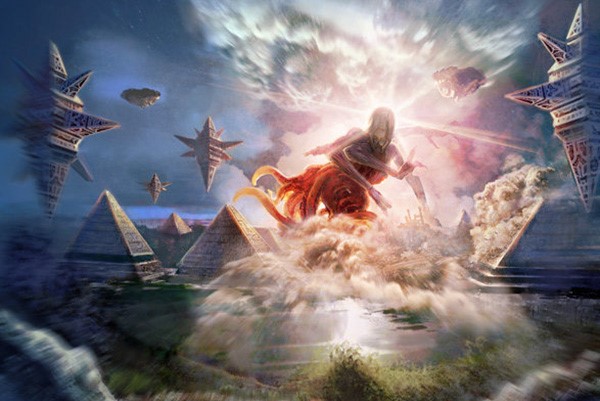
While having your board wipes attached to permanents can open up a vulnerability to removal that an instant or sorcery simply doesn’t have, it also opens up synergies with artifact-based decks and strategies.
Typically, this results in easy access to these board nukes via blue artifact tutors, reuse in combination with cards like Darksteel Forge, and options for clearing opposing threats while leaving yours intact. Your opponents may find this especially problematic once you get set up, as most colorless board wipes clear several permanent types at once.
The tradeoff for this potency comes in a couple different forms – high mana costs or a 1-turn delay. Compared to an efficient board wipe, which costs 4-5 mana, some colorless board wipes cost 7 or more mana to activate, and those that don’t usually enter the battlefield tapped or have another condition that makes you wait for activation.
So which colorless board wipes are best for your deck? I’ll be taking a look at the most appealing options, ranked loosely from worst to best, and going over the pros and cons each brings to the table. Then you can decide how they stack up against the other choices your deck is allowed to use in white, blue, black, red, and green.
False Floor
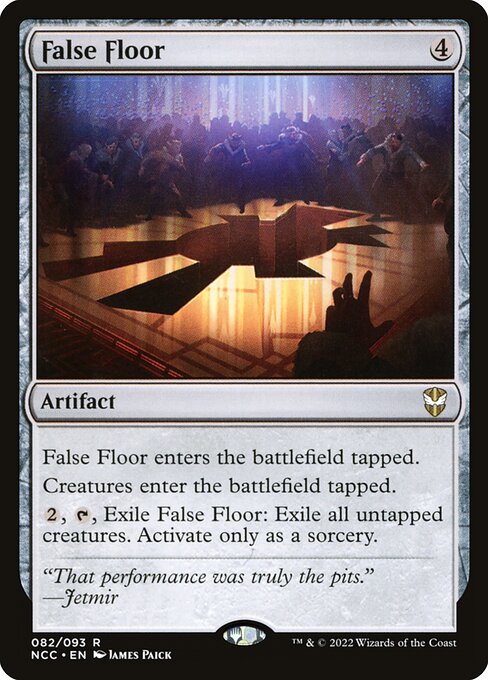
False Floor is a bit of an odd duck, even among colorless board wipes. On the one hand, it enters tapped and only gets rid of untapped creatures. It does at least exile them, getting around those that are indestructible, but paying an additional 2 mana (6 total over 2 turns) for a conditional sorcery speed board wipe isn’t a rate anyone is going to be excited about.
On the other hand, False Floor‘s passive effect is actually pretty good. Cards like Frozen Aether, Urabrask the Hidden, and Authority of the Consuls have always been playable ways to slow down opposing creatures in Commander, so giving an effect like this to green and black decks will undoubtedly be handy for specific strategies.
Unfortunately, the board wipe and passive effects of False Floor, while each individually adequate, work directly against each other. You can’t exile a creature that your opponents played during the last turn cycle because your own card forced it to enter the battlefield tapped, by which point it can attack and tap to duck the board wipe on your turn.
This means that ultimately, the control side of False Floor far outweighs the board wipe side, as it is reliable from the moment the artifact hits the table, and the board wipe effect is incidental at best. Goes to show you just how shallow the pool of colorless board wipes really is, as this made the cut over Worldslayer.
Noetic Scales

Unlike False Floor, Noetic Scales is an odd duck of a board wipe I can get behind. During each player’s upkeep, they have to return all creatures they control to their owners’ hands that have power greater than the number of cards they have in hand. This occurs before they draw, so this can be a brutal blow to tempo every single turn.
Naturally, decks that keep a lot of cards in their hand through card draw, tutoring, or conservative play patterns will fare pretty well with this card in play. making it easy for Noetic Scales to disproportionately punish decks focused on high power creatures or aggressive use of the cards in their hand.
For better or worse, this effect also makes it quite easy to reuse the abilities of creatures with effects that trigger upon being cast or entering the battlefield. If you’re staring down an Ulamog, the Ceaseless Hunger, a Sun Titan, or even an Eternal Witness, make sure you know what you could be getting into by putting this card into play.
Coercive Portal

I’m not a big fan of Conspiracy‘s Will of the council mechanic or others designed in its vein, as giving your opponents control of what happens with your cards will always result in them picking the most favorable outcome for their situation. Worse, Coercive Portal does absolutely nothing until a full turn cycle has passed.
If this card does survive to your next upkeep, however, the payoffs can both be quite attractive. If half or more of the players at the table are comfortable with the status quo, you get an extra card. If more than half the table feels things are getting out of hand, Coercive Portal can destroy all nonland permanents; a great rate for 4 mana.
The primary problem with this specific card is that if you play it early for extra cards, then get too far ahead of the table, you’ll either have to find a way to destroy it or watch helplessly as the table votes to erase your hard-earned progress.
Red decks that struggle to deal with enchantments, black decks that struggle to deal with artifacts and enchantments, and green decks that struggle to deal with creatures may all still find a use for this unwieldy board wipe though, as they simply lack better options for mass removal in these areas.
Personally, I’m more likely to choose a board wipe that gives me the choice of when to set it off, even if I have to pay a little more mana for the privilege.
Boompile
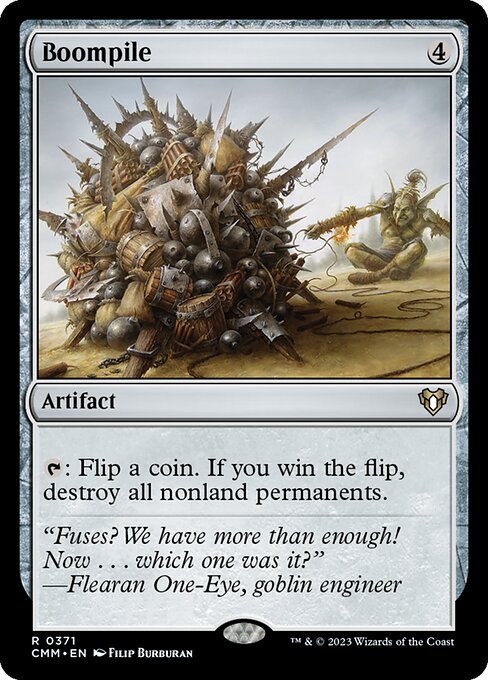
Boompile offers a different take on unwieldy 4 mana artifacts that can destroy all nonland permanents, relying on the flip of a coin instead of the consensus of the table. While it isn’t a card I’d prefer to bet on when I’m in a bind, I’ve had some success with this board wipe, even outside of decks that revolve around flipping coins.
There’s also something undeniably exciting about seeing a Boompile on the field. The tension that builds as the table waits to see if the board is about to explode is undeniable, especially if someone is charging ahead to try and deliver a finishing blow to the mad individual who put this conglomeration of explosives and fuses into play.
Whether the resulting coin flip results in an upset or not, someone is probably getting a great story out of the play.
Perilous Vault
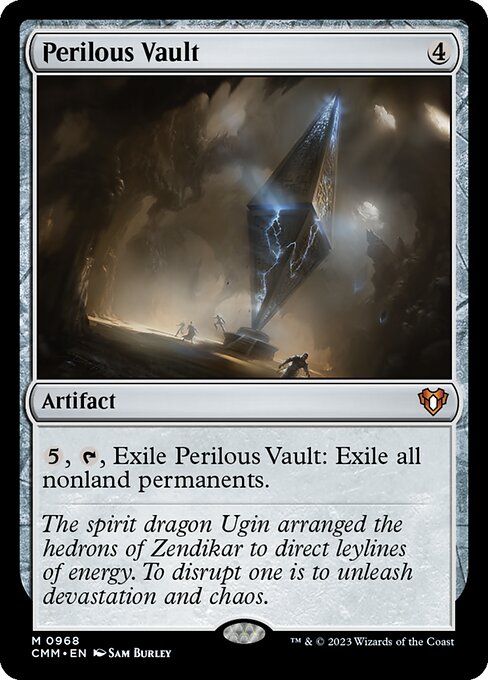
I’ll be the first to tell you that nobody is going to be all that excited about paying 9 mana to use Perilous Vault to wipe the board, even if it is across 2 turns, exiles all nonland permanents, and can be done on curve in a pinch by setting up during turns 4 and 5.
If you’re playing a colorless Commander deck or simply lack good options for addressing certain types of permanents, however, you’ll always take what you can get when it comes to dependable board wipes. Especially if it can be used on the same turn you play it during the late game.
Beyond its high mana cost, the only real drawback to Perilous Vault is that it exiles itself after you use its effect. This makes it a poor fit for decks that use indestructibility to abuse these sorts of effects, but a great answer to level against them if this is a problem in your metagame.
Even if this isn’t a problem in your meta, Perilous Vault is a solid board wipe for the decks that can consistently assemble the mana to harness its wrath and lack more cost-effective options.
Nevinyrral’s Disk
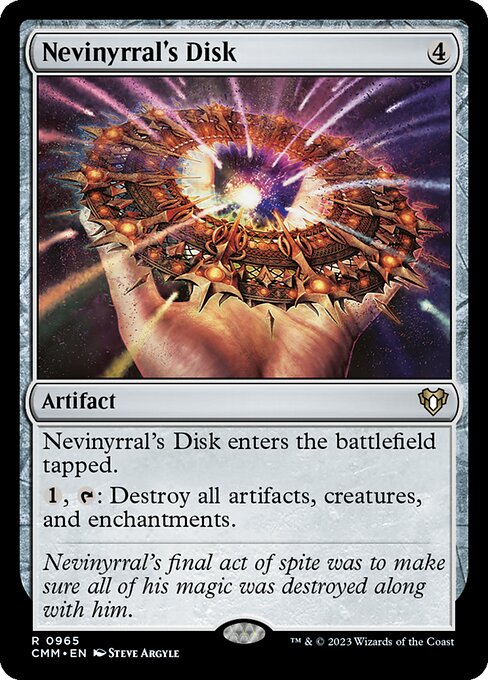
Speaking of old mainstays, Nevinyrral’s Disk is an infamous combo piece with Darksteel Forge for blowing up all your opponents’ relevant permanents at instant speed while leaving yours intact, and keeping the Disk in play so you can do it all again until everyone is dead each turn cycle.
Add Mycosynth Lattice if you also want to hit lands and planeswalkers, and the table will scoop pretty quickly.
While 5 mana over 2 turns isn’t the best in terms of cost or speed, Nevinyrral’s Disk strikes a balance between mana cost and reliability that makes it very attractive to a lot of players exploring the format, especially since it can go in any deck that wants it.
Even if you’re playing the Disk fairly, however, I’ve found it becomes an important teaching tool for table politics when it shows up in a Commander pod. As long as the Disk is out, nobody is going to want to commit anything that it can destroy until it is used or taken off the field by removal or other means.
If you intend to use it to hold a gun to the heads of the collective table, the longer it’s out, the more the table is going to band together against you until the Disk is gone. This means that you want to time playing it before an enemy board state is unstoppable, but with enough lead time that your board wipe is going to help set opponents back who are ahead.
This is an incredibly tricky tightrope to walk, and many simply elect to not use Nevinyrral’s Disk at all because of it (myself included). But I’m not convinced that’s the right take for all decks. Clearing artifacts, enchantments, and creatures at instant speed is incredibly powerful and potentially useful for a lot of monocolor decks, especially those on a budget.
Karn’s Sylex

When Karn’s Sylex previewed in Dominaria United, I was initially unimpressed. This board wipe has so many safety valves built into it that I was sure it’d be a bulk mythic. It’s legendary, it enters tapped, it can only be activated at sorcery speed, it exiles itself on use; I haven’t see a more cautious card design in a long, long time.
While this is no Pernicious Deed, Karn’s Sylex manages to remain an interesting colorless board wipe that learns from the deficiencies of False Floor. The static ability to shut off life payments for spells and activated abilities hits a very relevant subset of cards, including all-stars like fetchlands, Force of Will, and Necropotence.
Then when the need arises, Karn’s Sylex can be used on a later turn by spending the exact amount of mana you need to clear opposing threats while preserving the most expensive threats on your battlefield. At best, you come out ahead; at worst, you even things out. Not a bad package deal for 3 mana early on.
This combination of flexibility and potent effects is enough to overlook most of its drawbacks, except the sorcery speed activation timing. The inability to respond to removal is incredibly problematic, so you have to be extremely deliberate about using this card’s board wiping effect when you have the opportunity.
Waiting around or trying to attack before using it is a good way to get thwarted by an instant speed artifact removal spell, putting you in a much worse position than you were when your turn started.
Oblivion Stone
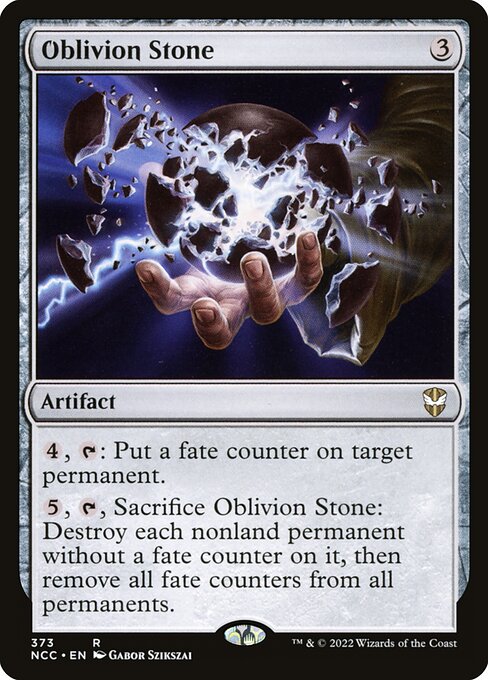
Did you know that Oblivion Stone was such a popular Commander board wipe upon a time, it was regularly more than $30? While it’s pretty easy to find copies under $5 today, Oblivion Stone was in a lot of decks back in the day for several reasons.
First, it could split its 8 mana cost across multiple turns, giving you something to do with your mana on turns 3, 4, and 5 back when the format was slower and prone to “battlecruiser” battles among high mana creatures. Being colorless, Oblivion Stone also didn’t care what type of mana you were using for any of its costs, giving it wide appeal.
If left alone for a while, you could set up fate counters to save your best permanents if you didn’t need to nuke the field right away, creating paths to break deadlocks and win games if your opponents weren’t paying attention or didn’t draw artifact removal.
It also only costs 3 mana to put into play, making it an extremely accessible recursion target for cards like Sun Titan or more modern versions of this effect like Recommission and Sevinne’s Reclamation. This allows you to board wipe until you can craft a board state where you are ahead and have worn down your opponents’ resources so you can close the game.
While artifact decks have historically been a domain that used to exclusively belong to blue and Sharuum the Hegemon, red and white have gotten a lot of commanders and support cards that make them viable choices without the same stigmas of these infamous older mainstays.
Oblivion Stone absolutely has a home in some of these new decks, and is also still worth a look if you simply need a way to remove permanents your deck struggles with en masse.
All is Dust
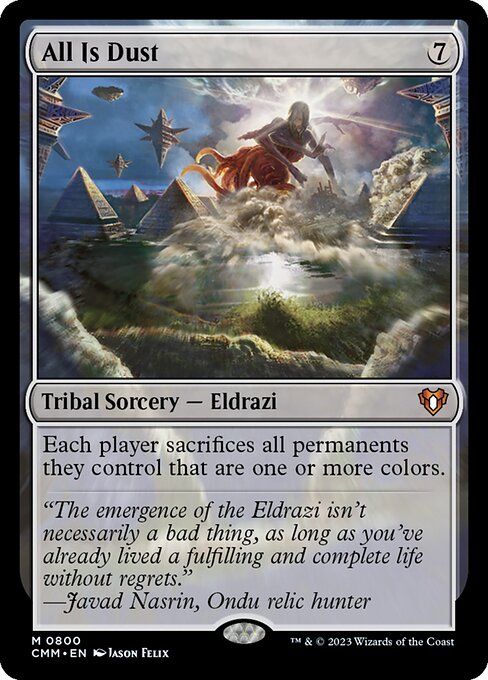
All is Dust was one of the most anticipated board wipes ever previewed in Rise of the Eldrazi, and with good reason. Colorless cards that weren’t artifacts, creatures, or the weird Ghostfire from Future Sight were a brand new concept thanks to the Eldrazi, and they’ve been all over Commander ever since.
Few match the impact All is Dust had then, and it’s still one of the most highly played colorless sorceries today. 7 mana to force everyone to sacrifice all colored permanents looks like a lot, but colorless decks make what looks like an evenhanded effect into an extremely lopsided affair, removing even indestructible threats with ease.
It also gave all decks a way to deal with permanents they struggled with. Blue could actually remove something without returning it to someone’s hand. Green could kill creatures. Red and black could get rid of enchantments. This added uncertainty to matchups that previously had ironclad advantages, which made a huge difference to how Commander games were played.
Mono green decks are where I generally play All is Dust nowadays, as green’s mana ramp tends to make 7 mana an easy mana cost to pay, but I still see this card pretty often in other decks within my local circles, and I don’t expect that to change anytime soon.
When Should I Play Colorless Board Wipes in MTG?
Colorless board wipes are generally turned to when you need a board wipe for permanents your Commander deck can’t easily deal with. Since their primary strength is the lack of a color identity, these cards can serve as critical stopgaps for addressing difficult matchups, even if they cost a lot of mana, require a turn to activate, or have unreliable activation conditions.
Since most colorless board wipes are also permanents, some are well suited to decks that revolve around recursion or cards that make your permanents indestructible, allowing you to mercilessly remove everything your opponents control while ensuring you’re the only one who can keep threats in play.
Some decks might not play a single colorless board wipe at all. White decks notably have access to a board wipe for virtually any occasion, so it’s rare that they’ll need to go to their bench for an answer to what their opponents are doing.
Each deck is different though, so take the time to explore all of your options. You might be surprised by what you discover in the process.
Other MTG Articles You Might Enjoy
- MTG White Board Wipes You Should Play in Commander
- MTG Black Board Wipes You Should Play in Commander
- Best Mana Rocks EDH
- Best Green Ramp for Commander
- Cheapest MTG Booster Box Locations
- Best Sites to Buy MTG Singles
Braden is a founder of Assorted Meeples and has been a gamer & writer with a vivid imagination all his life. Don’t believe us? Check out his excitement when meeting Goosebumps author R.L. Stine as a kid! An avid Magic: The Gathering spellslinger for over 15 years, you can always convince him to shuffle up for a game (or three!) of Commander.
